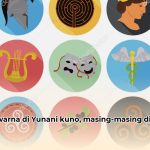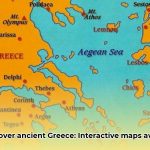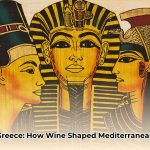Ever found yourself picturing ancient Greece as a monolithic, solely “white” civilization? Popular culture, textbooks, and cinematic portrayals have largely reinforced this narrative, often sidelining the rich tapestry of interactions and influences from diverse cultures. However, a deeper dive into archaeological findings and a critical re-evaluation of ancient Greek art and literature are compelling historians to broaden their perspectives. What emerges is a far more nuanced and remarkably diverse picture, suggesting that people of African descent held a more integrated and significant presence in this foundational Western society than previously acknowledged.
This exploration transcends a simple statement of African presence. It delves into the intricate ways Africans interacted with Greek culture, the societal roles they occupied, and the perceptions they encountered. From established trade connections with the sophisticated Minoans to their appearance in profound Greek myths, their service in military forces, and their consistent artistic representations, their integration prompts crucial questions about the true complexity of ancient Greek life and challenges deeply ingrained assumptions about its origins and composition.
Seeking the Evidence: Tracing African Connections in Early Greek History
The notion of an African presence in ancient Greece is supported by several widely accepted historical facts. Long before classical Greek ascendancy, the Minoan civilization, flourishing on the island of Crete around 1600 B.C.E., maintained extensive trade networks with ancient Egypt. This exchange facilitated a consistent flow of both goods and people between these major cultural hubs. Archaeologist Manfred Bietak’s extensive research, for instance, unearthed evidence from artwork as early as 7000 B.C.E. depicting early inhabitants of Greece as being of African descent, suggesting deep, ancient roots for this interaction. The Minoans themselves were known for their vibrant cities, opulent palaces, and advanced infrastructure like paved roads and piped water systems.
Moreover, the ancient Greeks consistently used the term “Ethiopian” to refer specifically to Black Africans. This consistent terminology, evident from as early as Homer in the 8th century B.C.E. and clarified by the 5th-century B.C.E. historian Herodotus, clearly indicates Greek recognition and designation of people originating from Africa. While applying modern racial categories to ancient societies requires caution, this designation was a clear acknowledgment of their distinct origin and appearance.
Artistic representations of Africans are abundant across various forms of Greek art, from pottery and sculptures to frescoes. These depictions range from mythological figures and scenes of daily life to portrayals of individuals in various societal roles, including athletes, entertainers, and, indeed, enslaved people. However, the exact interpretation of these visual records remains a subject of ongoing scholarly debate: Were these artistic expressions accurate reflections of Africans’ full societal roles, or did they sometimes lean toward symbolic or stereotypical portrayals?
Significant scholarly discussion also surrounds the Pelasgians, a mysterious group inhabiting Greece prior to the arrival of the “Greeks.” Some historians, drawing from older sources and physical descriptions (like being “dolichocephalic” or long-headed, as well as being short, black, and dark-haired), have proposed a potential connection between this pre-Greek population and African civilizations. Groups like the Garamantes, an ancient Libyan tribe known for their irrigation skills and chariot-racing prowess, are also proposed by some scholars as having shared connections, though this hypothesis remains highly debated and lacks widespread consensus among mainstream classicists. Understanding these nuanced interpretations is crucial for a comprehensive historical view.
Challenging Perceptions: Africans in Greek Art & Society
The ancient Greeks were far from isolated; they engaged dynamically with the African continent. This interaction reveals complex levels of integration that defy simplistic narratives of racial prejudice. Commerce with Egypt, for instance, established vital trade routes fostering vibrant cultural exchange. Greek settlements and trading posts along the Nile River and at Cyrene in North Africa, such as Naukratis, intensified these contacts from the 8th and 7th centuries B.C.E. onwards.
African figures, frequently identified as “Ethiopians,” appear prominently in Greek pottery, sculptures, and various art forms. These ancient artistic representations offer critical insights into their acknowledged presence. Notable examples include:
- Homer’s Epics: Even in the earliest Greek literature, like Homer’s Odyssey, figures such as Eurybates, Odysseus’s herald, are described as “wooly-haired” and “dark hued,” and are depicted with honor.
- Vase Paintings: The black glaze central to Athenian vase painting was ideally suited for representing black skin. Red-figure vases from southern Italy frequently featured Ethiopians, sometimes in scenes alluding to Egypt and the Nile, or even in equal competition, such as a tomb painting near Paestum showing an Ethiopian and a Greek in a boxing match.
- Sculptures and Masks: Archaeological finds, such as a mask discovered in a Bronze Age tomb in Cyprus, depict individuals with distinct African features. Preserved comic masks also indicate Ethiopians were often cast in Greek comedies, highlighting their presence in public life and entertainment.
- Coinage: Africans were even depicted on ancient Greek coins, holding places of honor. Delphus, for whom Delphi was supposedly named, and various African legendary heroes appeared on coinage from Athens, Lesbos, and Phocis.
These depictions directly challenge the long-held perception of a purely “white” ancient Greece. They illustrate Africans as integral characters within broader Greek society, participating in religious rites (as seen in depictions of worshippers of Demeter and Persephone in Acragas), serving as mercenaries for Egyptian pharaohs, and being present among King Xerxes’ troops during the Persian invasion of Greece in 480 B.C.E., leading to significant contact. Yet, the undeniable role of Africans in slavery, alongside Greeks and other non-Greek peoples, introduces a layer of complexity, compelling us to critically examine the nuances of Greek perceptions. Archaeological discoveries consistently validate this cross-cultural contact, painting a vivid picture of interwoven histories.
How Did Ancient Greeks View People of African Descent?
Let’s challenge some deeply ingrained assumptions. When we conjure images of ancient Greece, our minds often default to marble statues and idyllic, sun-drenched islands, overlooking elements that complicate this singular image. How did ancient Greeks view people of African descent? This question unlocks a multifaceted re-evaluation of history, revealing that cultural identity, wisdom, and character were often valued above skin color, in stark contrast to later Western racial constructs.
Early Greek literature provides clues to early, often amicable cultural exchanges. Homer’s epic poems, for example, refer to “Ethiopians” with notable respect, even suggesting divine favor, with Zeus himself dining with them. This portrayal aligns with the common ancient Greek belief that Ethiopians were considered close to the gods and were a venerable people. Later Greek thinkers like Diodorus spoke highly of the civilized people of Meroe (in modern Sudan), considering them the first to worship the gods and even viewing Egyptian civilization as derivative of their own. Lucian further noted the Ethiopians’ reputation for wisdom and their pioneering development of astrology.
While Greeks certainly observed physical differences, there is substantial evidence indicating they did not possess a concept of “racial superiority” based on skin color in the same way modern societies might. The orator Isocrates, around 380 B.C.E., famously suggested that the term “Greek” connoted a state of mind (dianoia) and education (paideia) rather than a race, implying an inclusive view of identity. Philosophical ideas about beauty, as voiced by Xenophanes, also suggested that beauty was relative, and that people portrayed their gods in their own image, regardless of their own physical type.
Instances of integration and lack of prejudice are also found in daily life accounts:
- Aristotle mentions a woman whose child had an Ethiopian father without condemnation.
- Plutarch discusses a woman of Ethiopian descent to explain a child’s appearance, not to argue against miscegenation, a concept alien to ancient Greeks.
- The comedian Menander humanized Africans in his plays, referring to them as “migrants who are far from home” and asserting that “the man whose natural bent is good, though his mother is Ethiopian, is nobly born,” emphasizing character over lineage.
- The sophist Herodes Atticus is recorded as having an African pupil, for whom he reputedly set up a statue after his death, demonstrating genuine regard.
These perceptions were clearly diverse, ranging from admiration and fascination for the exotic to a practical acknowledgment of Africans’ various societal roles, including athletes, entertainers, and even slaves. However, the prevailing evidence suggests that skin color itself was not a primary basis for systematic prejudice or a concept of innate inferiority, a stark contrast to later European-imposed racial hierarchies.
Black Figures in Greek Art: Beyond the Exotic
When we scrutinize ancient Greek art, what narratives do these visual records impart about the inhabitants of that era? The depictions of Africans, consistently termed “Ethiopians” by the Greeks, present a profoundly complex tableau. Were they merely exotic figures confined to mythological narratives, or did they occupy more substantial roles within the broader Greek societal fabric? Examining available sources reveals a reality far more intricate than often assumed.
From as early as the 8th century B.C.E., distinct representations of Africans emerge in Greek art. These portrayals were not arbitrary; they frequently emphasized characteristics like dark skin, often rendered with the black-glaze technique on pottery. One might find them on painted vases, sculpted into detailed figurines, or even expressed through the exaggerated features of comedic masks. But do these depictions convey more than just physical appearance?
Some scholars propose that the consistent presence of Africans in Greek art implies a significant degree of integration—a clear recognition of their existence within the expansive Mediterranean world. This includes depictions in scenes of everyday life, suggesting their presence was not always confined to the periphery. Conversely, other researchers point to compelling evidence of enslavement and occasional stereotyping, which also formed part of the complex social dynamics. It’s crucial to acknowledge that while ancient Greeks did not hold modern racial prejudice, they did engage in slavery, which affected various non-Greek peoples, including Africans.
Interpreting these images demands careful attention to nuance. The answer, it turns out, is rarely straightforward. Factors such as artistic license, the material condition of the artifact itself, and the overarching cultural context all play crucial roles in how we decipher these ancient visual messages. For instance, the term “black-glazed” is often used by art historians to describe a common type of Greek pottery, intentionally minimizing modern racial connotations while still acknowledging a probable association with depictions of dark-skinned figures. Archaeological evidence confirms that ancient Greeks were aware of Africans (“Ethiopians”) through commerce, mythology, and warfare as early as the 8th century B.C.E.
The term “Ethiopian” itself was not a simple, race-based descriptor; it encompassed a broad spectrum of meanings for the Greeks, intertwining mythology, geographical understanding, and various societal roles. Furthermore, some researchers provocatively suggest that groups like the Pelasgians and Garamantes, often associated with early Greek history, were in fact “Black” civilizations that exerted significant influence, with descriptions of the Pelasgians noting their dark skin, curly hair, and advanced building skills. This proposition ignites intense scholarly debate concerning the ethnic composition of ancient Greek populations and their profound connections to African cultures. The racial composition of early Greek populations and their connections to Africa remains a subject of considerable scholarly discussion.
Core Insights into Ancient Greece’s Diverse Past
Understanding the integrated presence of people of African descent profoundly reshapes our perception of ancient Greece. Here are three pivotal points gleaned from current scholarship:
- Ancient Greece was a significantly more diverse and multi-ethnic society than traditionally portrayed, with a demonstrable and integrated African presence that challenges prevailing Eurocentric historical narratives.
- The evidence supporting this African presence is robust, encompassing established ancient trade routes with civilizations like Egypt and Nubia, the consistent use of Greek terminology such as “Ethiopian” to denote Black Africans, and extensive artistic depictions across various media (e.g., vase paintings, sculptures, comedic masks, coinage).
- A critical and nuanced approach is essential for interpreting this historical evidence, requiring acknowledgment of both integration and potential biases in ancient depictions, and a commitment to re-evaluating historical accounts to promote a more inclusive and accurate understanding of the past. This includes recognizing that while physical differences were noted, the modern concept of systemic racial superiority based on skin color was largely absent in ancient Greek thought.
Actionable Steps for a More Inclusive Future
To foster a deeper, more accurate understanding of Africans in ancient Greece and rectify past omissions, consider these actionable steps:
- For Academics and Historians: Re-evaluate existing interpretations of Greek art and literature, moving beyond simplistic narratives. Prioritize rigorous primary source analysis to understand potential biases, aiming for a richer understanding of historical nuances. Develop inclusive curricula that accurately reflect the ancient world’s multicultural realities, challenging entrenched Eurocentric biases in historical education, enhancing narrative accuracy.
- For Museums and Cultural Institutions: Contextualize African depictions in exhibits to acknowledge both integration and potential power dynamics, striving for increased public engagement. Actively promote research collaborations between Western and African scholars to ensure multifaceted perspectives on Greek-African interactions, fostering broader scholarly representation.
- For Educators: Incorporate updated historical information into lesson plans, emphasizing the multiethnic nature of ancient societies, with a goal of comprehensive student comprehension of diversity. Encourage students to think critically about existing historical narratives and explore different perspectives, fostering enhanced critical thinking skills.
- For Cultural Organizations and the General Public: Engage in open public dialogues about the appropriation of ancient Greek culture and its impact on modern perceptions of race and identity, aiming for increased public awareness. Actively work to decouple ancient legacies from systemic racism and encourage broader inclusivity, fostering greater cultural alignment. Seek out diverse sources of information and engage in constructive discussions about race, representation, and cultural appropriation to achieve a more informed public discourse.
By actively taking these steps, we can collectively challenge systemic biases, promote more inclusive and comprehensive historical narratives, and ensure that the story of ancient Greece is told in its rich, multifaceted entirety. It’s about ensuring everyone has a seat at the table of historical understanding and honoring the full scope of human civilization.
Citations:
- The Metropolitan Museum of Art, “Africans in Ancient Greek Art”
https://www.metmuseum.org/essays/africans-in-ancient-greek-art - “What was the ancient Greeks view on people of African descent? – Africans in Ancient Greece and Greek Art”
https://www.greecehighdefinition.com/blog/2019/11/24/what-was-the-ancient-greeks-view-on-people-of-african-descent-africans-in-ancient-greece-and-greek-art - “Pelasgians & Garamantes: The Blacks Of Ancient Greece”
https://www.afrikaiswoke.com/pelasgians-garamantes-the-blacks-of-ancient-greece/
- Unearth ancient rome achievements: Engineering feats & legal legacies, examined - August 13, 2025
- Unlock ancient rome army ranks: Power, impact & legion command - August 13, 2025
- Conquer Your Exam: Ancient Greece Quiz Ace It Now! - August 13, 2025
















